
Dipterygium glaucum /صفير
Dipterygium scabrum Decne. ex Boiss.
Safir
Safrawi
Capparaceae
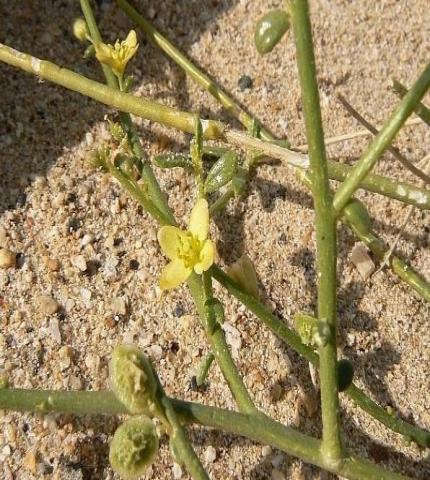
Aerial parts
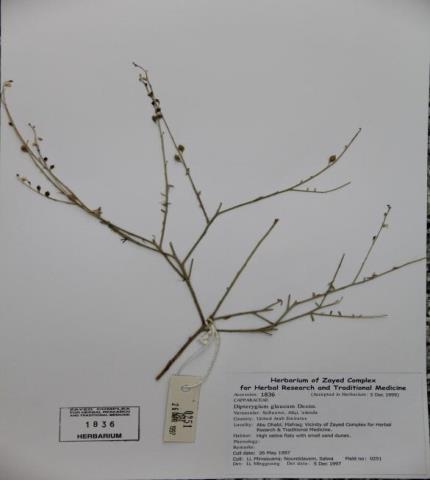
Herbarium specimen
Ethnobotanical Characteristics
Description
Abundantly branched under shrubs, up to 60 cm tall, glabrous rarely glandular, woody at the base; branches slender, terete, apparently leafless. Leaves elliptic-oblong, 3-10 (-15) mm long, 2-3 mm broad (incl. 0.5-1 mm long petiole), sub fleshy, glabrous (basal and lower leaves in young plants broader and with longer petiole). Flowers minute, in lax ebracteate or bracteate racemes; pedicels 2-3 mm long, filiform. Sepals 1.5-2 mm long, 0.7 mm broad, ovate-oblong, acute or acuminate. Petals 3-4 mm long, 1.5-2 mm wide, ovate-elliptic, apex obtuse, yellowish. Stamens 6, alike, about as long as the petals; filaments simple, linear, anthers about 1 mm long, ovoid. Fruits 3-6 mm long, 2.5-6 mm broad, ellipsoid, sub compressed, often slightly winged, indehiscent, usually one seeded, somewhat crustaceous. (Jongbloed, 2003, eFloras, Mandaville, 1990).
Habitat and Distribution
Deep sands of semi-stabilized dune areas; found in Arabia, Egypt, Sudan and W. Pakistan. Rare, on gravel plains north of Hili near Al Ain; all plants stunted, smaller ones spinescent and covered with minute leaves; larger trees umbrella like, with normal foliage only above reach of camels. (eFloras, Western, 1989).
Part(s) Used
Whole plant
Traditional and Medicinal Uses
This plant is analeptic and asthmatic; used to treat asthma (Fitoterapia 75 (2004) 149-161) and used in other countries to treat respiratory diseases (Jongbloed, 2003). It is used as tonic, stomachic, aphrodisiac, alterative and expectorant (Fawzy Kotb, 1985).
Pharmacognosy and Phytochemistry
Plant material studied
Leaves
General appearance
It is a grayish green oblong leaf, small in size to 12 mm long, petiolate. It is brittle and easily broken.
Microscopic characteristics
A surface view of the leaf shows that both epidermises consist of small polygonal cells that also bear covering and glandular trichomes. The venation has an intricate network. A cross-section of the leaf exhibits its dorsiventral characteristic and cells of both epidermises are small and oblong in shape and bulge outwards into small angular arch-like protrusions. Both epidermises bear conical glandular trichomes with blunt tapering heads and multiseriate stalks. They also bear peculiar brownish branching covering trichomes whose branches are quite slender and they are cilia-like structures originating from few cells of multicellular stalks and these are particularly found more on the lower epidermis. Stomata are few and they are oval in shape and confined to the lower epidermis. The palisade layer underlying the upper epidermis consists of slender closely packed parenchyma cells with blunt heads. They contain chloroplasts and small coloured masses. The spongy mesophyll tissue consists of about five layers of rounded or oblong cells containing chloroplasts; cells embedding the vascular tissues are compressed elongated parenchyma cells. The xylem vessels are either annularly or spirally thickened. Some spongy cells adjacent to the lower epidermis contain brownish masses.
Dried stem and branches
General appearance
It is light green in colour and it branches at the internodes into straight branches. It has a square cross-section and the surface is tomentose and it gives a coarse feeling when held between fingers.
Microscopic characteristics
A transverse section of the stem shows that it is almost circular in outline. The epidermal layer consists of almost square cells with thick walls bulging outwards forming small arches. The epidermis is covered with thick striated cuticle and it also bears oblong to cylindrical glandular trichomes of different sizes and they have blunt heads. The epidermis is underlain by a number of cortical layers; the exterior layers of the cortex (about 4-5 layers) consist of collenchymas cells while the majority (interior ones) are compressed elongated parenchyma cells that embed isolated groups of long heavily lignified fibers. These layers of parenchyma surrounded a circle of vascular tissues; the phloem tissues are slightly lignified while the xylem tissues are heavily lignified. The pith occupies a large central zone. It is composed of rounded parenchyma cells with thick pitted walls and they are also heavily lignified.
Powdered plant material
The material consists of the pounded aerial parts. It is alight greenish-yellow somewhat homogeneous fine powder. It has a slight sour acrid taste and a characteristic odour reminiscent of dried fermented tobacco leaves. Microscopically, the powder shows that the majority of fragments belong to stem and branches. Fragments of the leaf are represented by the epidermal surfaces with thick striated cuticle. The upper epidermis is shown with its conical glandular trichomes with their blunt heads. The leaf fragments also show a significant network of venation and few slender covering trichomes. The fragments of the stem and branches show long grayish-yellow groups of fibers in addition to groups of vascular tissues with reticulately thickened vessels. There are also occasional free short spirally thickened vessels.
Parts studied
leaf and stem
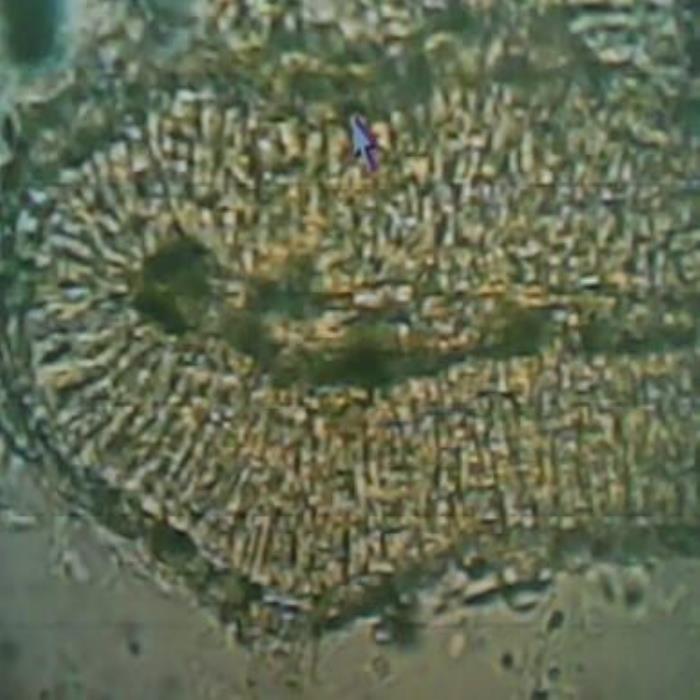
A) TS of leaf
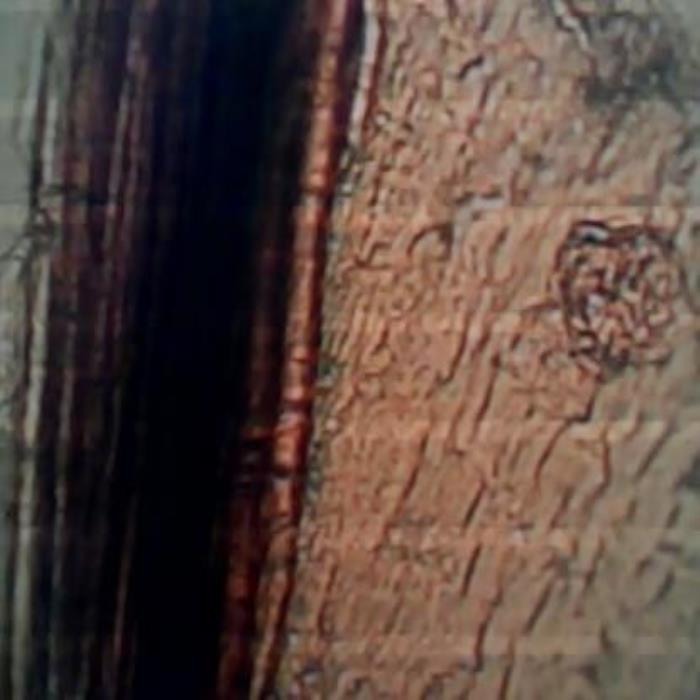
B) Surface view of stem
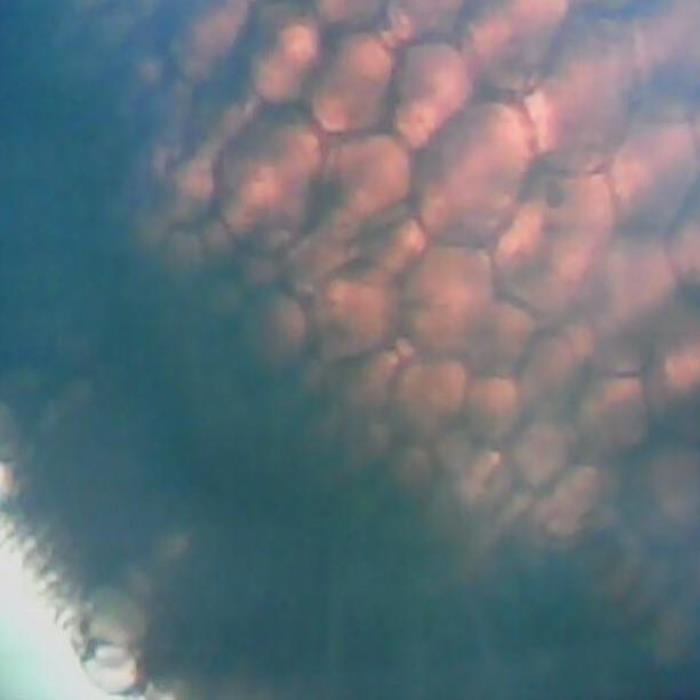
C) TS of stem
- A. TS of the leaf near the margin showing both epidermises bulging into small angular arch-like protrusions and also bearing glandular trichomes and slender branching covering trichomes more found on the lower epidermis. Both palisade and spongy tissues are rich in chloroplasts and spongy cells near to lower epidermis contain brownish masses.
- B. A surface view of a portion of the stem from below showing part of the epidermal cells, some cortical collenchyma cells, compressed elongated cortical parenchyma cells and groups of long heavily lignified fibres.
- C. TS of a portion of the stem showing the slightly lignified phloem tissues, the heavily lignified xylem tissues and the heavily lignified rounded pith cells that have thick pitted walls.
Chemical constituents
Alkaloids, flavonoids, sterols and/or terpenes, tannins and saponins (El-Ghonemy, 1993). Total carbohydrates 0.156% (0.174; reducing sugars and0.041% non-reducing), starch contents 0.053%, crude fibers 26.83%, crude fats 13.30% and nitrogen contents 0.014%. Concentration of sodium was 3.3%, Potassium 37.6%, lithium 0.1%, Calcium 0.01%, Magnesium 0.022%, nickel 0.764%, copper 2.372%, manganese 0.003%, Sulphur 0.8% and Phosphorous 1.60%. Moisture and ash contents were 5.60% and 4.75% respectively. alkaloids, glycoside, cardiac glycoside, bound anthraquinones and saponins were present, while flavonoids and unbound anthraquinones were absent (Karamat,2010).
The following chemical studies have been carried out (Quality Control methods, 1998; Evans, 1996) on the aerial part of the plant Dipterygium glaucum (ZCHRTM unpublished work)
Physicochemical constants
Loss of weight on drying at 105°C: 9.90
Absolute alcohol solubility: 4.40
Water solubility: 8.10
Successive extractives (%)
Petroleum ether (60-80) °C : 2.35
Chloroform : 1.10
Absolute alcohol : 4.95
Ash values (%)
Total ash : 5.70
Water soluble ash : 2.30
Acid insoluble ash (10% HCl) : 0.20
pH values (aqueous solution)
pH of 1% solution : 5.895-5.909
pH of 10% solution : 5.361-5.365
Elemental analyses
Ash values (British Herbal Pharmacopeia)
Assay and identification of metal (AOAC International)
|
Apparatus |
AA-6800 Shimadzu-Flame method |
||||
| Element | Std. conc. µg/ml (ppm) | Sample conc.mg/ml | Sample absorbance | Actual conc.mg/ml | Actual conc. (%) |
|
Cr |
1, 2, 4 |
20 |
0.0042 |
0.0000822 |
0.00000822 |
|
Zn |
0.25, 0.5, 1 |
20 |
0.1926 |
0.0093950 |
0.0009395 |
|
Cu |
1, 2, 4 |
20 |
0.0191 |
0.0054 |
0.00054 |
|
Fe |
1, 2, 4 |
20 |
0.5187 |
0.218335 |
0.0218335 |
|
K |
1, 2, 4 |
1 |
0.5932 |
5.3382002 |
0.5338202 |
|
Pb |
1, 2, 4 |
20 |
0.000 |
0.000 |
0.000 |
|
Cd |
0.25, 0.5, 1 |
20 |
0.0039 |
0.00018 |
0.000018 |
|
Ca |
5, 10, 20 |
1 |
0.0327 |
6.1345 |
0.61345 |
UV Spectral studies
|
Ultraviolet Spectrum (USP) |
||||
|
Apparatus |
Milton Roy Spectronic Genesys 5 Spectrophotometer - Milton Roy. |
|||
|
Sample conc. (mg / ml) |
Solvent |
λ max (nm) |
λ min (nm) |
Abs. ( λ max - λ min) |
|
1.00 |
Intestinal Fluid simulated without pancreatic pH=7.50.1 |
274 |
256 |
0.752 -0.643 |
|
1.002 |
Gastric Fluid simulated without pepsin pH =1.20.1 |
268 322 |
253 307 |
0.591 - 0.542 0.436 - 0.415 |

Intestinal Fluid simulated without pancreatic

Gastric fluid simulated without pepsin
Chromatographic Studies
Thin layer chromatography (Wagner and Bladt, 1996)

A

B

C

D
TLC fingerprint of Petroleum ether 60-80°C (track 1) and Methanol extract (track 2)
|
Mobile phase Fig. |
A |
: |
Toluene, ethyl formate, formic acid (5:4:1) |
|
|
B |
: |
Ethyl acetate, methanol, water (100:13.5:10) |
|
|
C |
: |
Toluene, ethyl formate, formic acid (5:4:1) |
|
D |
: | Toluene, ethyl acetate (93:7) | |
|
Detection |
A |
: |
UV 254nm |
|
|
B |
: |
UV 356nm |
|
Derivatization |
C&D |
: |
Vanillin-Sulphuric acid- vis. |
Pharmacological and toxicological studies
Aqueous extract
Pharmacological and toxicological information of the plant reported in the literature:
The n-hexane (B), ethyl acetate (C) and n-butanol (D) fractions of D. glaucum exhibited no or little antibacterial, antifungal, antileishmanial and insecticidal activities as compared with their respective controls (Saeed, 2006). Ethanol (80%) extract (A) of the plant was sub-fractioned by hexane (B), ethyl acetate (C) and butanol (D). These fractions (1 mg/ ml) of D. glaucum showed 45 to 100% phytotoxicity as determined by the inhibition of Lemna minor plant growth but showed no cytotoxicity by brine shrimp lethality assay. Positive Antioxidant activity and antispasmodic activity were also reported. Phyto-sociological studies of Dipterygium glaucum along with other plants (Mansoor,2002).
The following pharmacological and safety evaluation studies were carried out on the aqueous plant extract of Dipterygium glaucum (Derelanko 2002; Han, 2003).
|
ACTIVITY |
RESULTS |
|||
|
Strong |
Moderate |
Mild |
Negative |
|
|
Effect on rabbit jejunum |
|
|
|
√ |
|
Effect on rat fundus |
√ |
|
|
|
|
Effect on Guinea pig ileum |
√ |
|
|
|
|
Effect on Guinea pig tracheal chain |
|
|
|
√ |
|
Effect on right rat atria |
√ |
|
|
|
|
Antithrombotic effect |
|
|
|
√ |
| Studies on biochemical (Crea, BUN, AST & ALT) reduced | √ | |||
|
Studies on hematological (WBC & PLT) decreased |
√ |
|
|
|
|
Locomotor activity test |
|
|
|
√ |
|
Motor co-ordination (grip strength & motor activity |
|
|
|
√ |
|
Rectal temperature reduced |
√ |
|
|
|
|
Body weight |
|
|
|
√ |
|
Acute toxicity |
|
|
|
√ |
|
Mortality |
|
|
|
√ |
|
LD50=> 5g/kg |
|
|
|
˃5g/kg |
Summary of the results
The plant extract produced spasmodic activity as evidenced by rat fundus activity. The plant extract might be helpful in reducing the propulsive action of the gut function. The plant extract could be used as digestive and carminative. The plant extract produced rapid increase in amplitude following the response of the extract using guinea-pig isolated ileum, may contribute to the laxative effect. The plant extracts might be used in constipation.
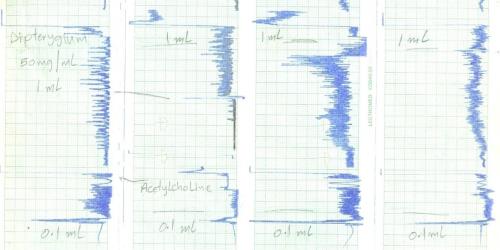
The effect of Dipterygium on Acetylcholine pre-contracted isolated Guinea pig ileum in organ bath
The plant extract showed positive inotropic agents increase myocardial contractility, and are used to support cardiac function by increasing the strength of muscular contraction as cardio-protective effect or myocardial stimulant, having a tonic effect on the heart.
The present results revealed that the plant extract showed no change in any of the parameters studied; showed no bronchi-dilatory effects on histamine- induced tracheal chain of the Guinea pig; produced no effect in the amplitude the spontaneous contraction of the isolated rabbit jejunum. Following the plant extract administration for 15 days blood Urea nitrogen, Aspartate aminotransferase and Alanine transaminase were found significantly reduced as compared to the control values.
The hematological analysis showed that RBCS, HGB and MCV have slightly increased while WBCs significantly decreased as compared to the control. The rest of the parameters stayed normal.
Safety evaluation studies revealed that the single oral dose of the test substance did not produce any adverse effect on the general behavior and gross appearance of the internal organs of mice. The LD50 of aqueous extracts was found to be greater than 5g/kg when administered once via gastric intubation to mice.
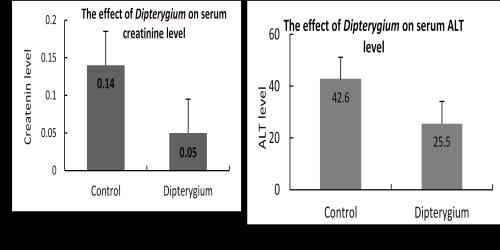
The effect of Dipterygium on BUN

The effect of Dipterygium on Haematological parameters
Antimicrobial activity
The aqueous extract of the whole plant was tested against Mycobacterium smegmatis, Candida tropicalis, Candida albicans, different strains of Methicillin Resistant Staphylococcus aureus, different strains of ESBL-producing K. pneumonia, E. coli, Pseudomonas aeruginosa and showed weak antimicrobial activity against Mycobacterium smegmatis and C. albicans but strong antifungal activity against C. tropicalis.
References
- El-Ghonemy, A. A. (1993). Encyclopedia of Medicinal plants of the United Emirates. 1st Edition. University of U.A.E.p250.
- Fawzi, M. K. (1995). Weeds in the U nited Arab Emirates. University of U.A.E.
- Fitoterapia 75 (2004) 149–161.
- Flora of Pakistan; www.efloras.org
- Jonbloed, M. V., Feulner, G. R., Boer, B. & Western, A. R. (2003). The comprehensive Guide to the Wild Flowers of the United Arab Emirates, Erwda, Abu Dhabi, U.A.E.
- Karamat Mehmood*, Shakira Mehmood, Memona Ramzan,M. Arshad , Farhat Yasmeen
- Biochemical and Phytochemical analysis of Dipterigynum glaucum collected from cholistan desert, Journal of Scientific Research Vol. XXXX No. 2, December, 2010 ,ISSN 0555-7674.
- Mandaville, J. P. (1990). Flora of Eastern Saudi Arabia. Kegan Paul International, Riyadh, Saudi Arabia.
- Mansoor H , A. Al Chaudhry, M. A Maan and Anwar H. Gill. Diversity of plant species in Lal Suhanra National Park, Bahawalpur, Pakistan Journal of Biological Sciences, 2002, 2: 267-274.
- Miller, A. G. and M. Morris. 1988. Plants of Dhofar, The Southern Region of Oman. Traditional Economic and Medicinal Uses. Diwan of Royal Court Sultanate of Oman—Holmes MC Dougall,Edinburgh, Scotland.
- Saeed A , Mohammad A , Abdul , Khalid H J, Shafiq M. K , Nisar-ur-Rahman and Munawar H. Biological Activity of Dipterygium glaucum Pakistan, Journal of Biological Sciences, 2006, 9: 1173-174.
- Shahina A. Ghazanfar. (1994). Handbook of Arabian Medicinal Plants. CRC Press.
- Western, A. R. (1986;1989) The Flora of United Arab Emirates. An introduction. –Al Ain. Publications of the U.A.E. University.
